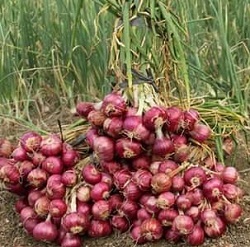
Effect of reducing rates of NPK, ZA, and KCl fertilizers on the growth and yield of shallot in multiple cropping system in Bantul
Karsidi Karsidi(1*), Endang Sulistyaningsih(2), Didik Indradewa(3), Budiastuti Kurniasih(4)
(1) Postgraduate of Agronomy, Faculty of Agriculture, Universitas Gadjah Mada Jln. Flora no.1, Bulaksumur, Sleman, Yogyakarta 55281
(2) Department of Agronomy, Faculty of Agriculture, University of Gadjah Mada Jln. Flora no.1, Bulaksumur, Sleman, Yogyakarta 55281
(3) Department of Agronomy, Faculty of Agriculture, University of Gadjah Mada Jln. Flora no.1, Bulaksumur, Sleman, Yogyakarta 55281
(4) Department of Agronomy, Faculty of Agriculture, University of Gadjah Mada Jln. Flora no.1, Bulaksumur, Sleman, Yogyakarta 55281
(*) Corresponding Author
Abstract
The intensive application of synthetic/inorganic fertilizer on shallot cultivation tends to contaminate the environment and reduce soil quality. Meanwhile, the decrease of farmland area has been a limiting factor in increasing shallot production. Shallot farmers in Bantul District, D. I. Yogyakarta, commonly combine organic and inorganic fertilizers. Therefore, an alternative technology to sustain the production of shallot is through the application of fertilizer at the right rates and the practice of multiple cropping system. The objective of this research was to determine the growth and yield of shallot as affected by the reduced rates of inorganic fertilizer in multiple cropping systems. This research was conducted from August to November 2016 in Srigading Village, Sanden Sub-District, Bantul District, D. I. Yogyakarta. The research was arranged in a split plot design with three replications. The main plot was cropping system consisting of monoculture system (shallot) and multiple cropping system (shallot – chili). The subplot was fertilizer rates consisting of 100 % as control, 50 %, and 25 %. The results of this research showed that multiple cropping system did not decrease the growth and yield of shallot. Likewise, reducing inorganic fertilizer rates to 50% of control did not decrease shallot yield. However, the inorganic fertilizer rate of 25% significantly decreased shallot yield to 12.15 %.
Keywords
Full Text:
PDFReferences
Azam-Ali, S.N. 2003. Multiple cropping. p. 978-984. In: B. Thomas (ed.). Encyclopedia of Applied Plant Sciences. London: Elsevier.
Badan Pusat Statistik Kabupaten Kulonprogo. 2015. Berita resmi statistik. No. 46/08/34/Th.XVII. https://kulonprogokab.bps.go.id/backend/brs_ind/brsInd-20150803155604.pdf.
Badan Pusat Statistik Provinsi D.I. Yogyakarta. 2016. Jumlah curah hujan per Bulan menurut Kabupaten/Kota di D.I Yogyakarta (mm), 2015-2018. https://yogyakarta.bps.go.id/dynamictable/2016/11/23/11/jumlah-curah-hujan-per-bulan-menurut-kabupaten-kota-di-d-i-yogyakarta-mm-.html.
Balai Penelitian Tanah. 2009. Analisis kimia tanah, tanaman, air, dan pupuk. http://balittanah.litbang.pertanian.go.id/ind/dokumentasi/juknis/juknis_kimia2.pdf
Chen, B.M., Z.H. Wang, S.X. Li , G.X. Wang, H.X. Song, and X.N. Wang. 2004. Effects of nitrate supply on plant growth, nitrate accumulation, metabolic nitrate concentration and nitrate reductase activity in three leafy vegetables. Plant Science, 167: 635–643.
Daras, U., O. Trisilawati, and E. Randriani. 2011. Respon jambu mete bermikoriza terhadap pengurangan dosis pupuk NPK. Buletin RISTRI, 2: 361-368.
Farhad, I.S.M., M.M.U. Chowdhury, S.K. Bhowal, A.K. Choudhury, and A.S.M.M.R. Khan. 2014. Chilli – garlic intercropping system in coastal saline area. Applied Science Reports, 6: 47-50.
Firmansyah, I. and N. Sumarni. 2013. Pengaruh dosis pupuk N dan varietas terhadap pH tanah N-total tanah, serapan N, dan hasil umbi bawang merah (Allium ascolanicum L.) pada tanah entisols-Brebes Jawa Tengah. Jurnal Hortikultura, 23: 358-364.
Ghozali, I. 2010. Pengaruh pupuk npk zeo-hukalsi terhadap ketersediaan kalium dan serapannya oleh tanaman bawang merah di Pasir Pantai Bugel, Kulon Progo. Universitas Gadjah Mada. Yogyakarta. (Undergraduate Thesis).
Hartiko, H.E., J. Del Rosario, and J.T. Carlos. 1982. Leaf and root nitrate reductase activities of coconut (Coconut nucifera L.) cultivars and hybrids. JIPI., 3: 227-235.
Hossain, M. S., M. A. Kader, and N. Islam. 2017. Multiple cropping for sustainable and exaggerated agricultural production system. Journal of Bioscience and Agriculture Research, 14: 1202-1209.
Janti, G. I., E. Martono, and Subejo. 2016. Perlindungan lahan pertanian pangan berkelanjutan guna memperkokoh ketahanan pangan wilayah. Jurnal Ketahanan Nasional, 22: 1-21.
Jasmi, E. Sulistyaningsih, and D. Indradewa. 2013. Pengaruh vernalisasi umbi terhadap pertumbuhan, hasil dan pembungaan bawang merah (Allium cepa L. Aggregatum group) di dataran rendah. Ilmu Pertanian (Agricultural Science), 16: 42-57.
Jazilah, S., Sunarto, and N. Farid. 2007. Respon tiga varietas bawang merah terhadap dua macam pupuk kandang dan empat dosis pupuk anorganik. Jurnal Penelitian dan Informasi Pertanian “Agrin”, 11: 43-51.
Kumar, S., D. Machiwal, D. Dayal, and A. K. Mishra. 2017. Enhanced quality fodder production through grass-legume intercropping under arid eco-system of Kachchh, Gujarat. Legume Research, 40: 896-900.
Masnanto, A. and E. Sulistyaningsih. 2006. Pengaruh jarak tanam dan dosis urea terhadap pertumbuhan hasil dan kualitas umbi bibit bawang merah (Allium cepa L. Aggregatum group). Universitas Gadjah Mada. Yogyakarta. (Dissertation).
Novizan, 2005. Petunjuk pemupukan yang efektif. 1st ed. Jakarta: Agromedia Pustaka.
Pandey, M., and T. Singh. 2015. Effect of intercropping systems and different levels of nutrients on dry matter ccumulation and physiological growth parameters of bed planted wheat (Triricum aestivum L.). Indian Journal of Science & Technology, 8: 1-6.
Sakya, A.T., E. Sulistyaningsih, D. Indradewa, and B.H. Purwanto. 2015. Tanggapan distribusi asimilat dan luas daun spesifik tanaman tomat terhadap aplikasi ZnSO4 pada dua interval. Jurnal Hortikultura, 25: 311-317.
Sharma, R. C. and P. Banik. 2013. Baby corn-legumes intercropping system: weed dynamics and community structure. Wageningen Journal of Life Sciences, 67: 11-18.
Sumarni, N., G.A. Sopha, and R. Gaswanto. 2012a. Respons tanaman bawang merah asal biji true shallot seeds terhadap kerpatan tanaman pada musim hujan. Jurnal Hortikultura, 22: 23-28.
Sumarni, N., R. Rosliani, and R.S. Basuki. 2012b. Respon pertumbuhan, hasil umbi, dan serapan hara npk tanaman bawang merah terhadap berbagai dosis pemupukan NPK pada tanah alluvial. Jurnal Hortikultura, 22: 366-375.
Suwandi, G.A. Sopha, and M.P. Yufdy. 2015. Efektivitas pengelolaan pupuk organik, NPK, dan Pupuk Hayati Terhadap Pertumbuhan dan Hasil Bawang merah. Jurnal Hortikultura, 25: 208-221.
Article Metrics
Refbacks
- There are currently no refbacks.
Ilmu Pertanian (Agricultural Science) ISSN 0126-4214 (print), ISSN 2527-7162 (online) is published by Faculty of Agriculture Universitas Gadjah Mada collaboration with Perhimpunan Sarjana Pertanian Indonesia (PISPI) and licensed under a Creative Commons Attribution-ShareAlike 4.0 International License.













